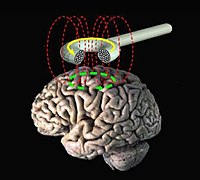
Photo from wikipedia
We aimed to identify neural mechanisms underlying clinical response to repetitive transcranial magnetic stimulation (rTMS) in post-stroke depression (PSD) by the Resting-state functional magnetic resonance imaging (rs-fMRI). Thirty-two depressed patients… Click to show full abstract
We aimed to identify neural mechanisms underlying clinical response to repetitive transcranial magnetic stimulation (rTMS) in post-stroke depression (PSD) by the Resting-state functional magnetic resonance imaging (rs-fMRI). Thirty-two depressed patients after ischemic stroke were randomized in a 1:1 ratio to receive 20 min of 5 Hz rTMS or sham over left dorsolateral prefrontal cortex (DLPFC) in addition to routine supportive treatments. The clinical outcome was measured by the 17-item Hamilton Depression Rating Scale (HDRS-17), while the imaging results were acquired from rs-fMRI, including regional homogeneity (ReHo), fractional amplitude of low-frequency fluctuation (fALFF) and seed-based dynamic functional connection (dFC). HRSD-17 scores were improved in the two groups after treatment (P < 0.01), while greater mood improvement was observed in the rTMS group (P < 0.05). Compared with the sham group, the rTMS group demonstrated regions with higher ReHo and fALFF values locating mainly in the left hemisphere and highly consistent with the default mode network (DMN) (p < 0.05). Using the medial prefrontal cortex (mPFC) and posterior cingulate cortex (PCC) as seeds, significant difference between the two groups in dFC within the DMN was found after treatment, including 10 connections with increased connectivity strength and 2 connections with reduced connectivity strength. The ReHo, fALFF and dFC values within DMN in the rTMS group were negatively correlated with the HDRS scores after treatment (P < 0.05). Our results indicated reductions in depressive symptoms following rTMS in PSD are associated with functional alterations of different depression-related areas within the DMN.
Journal Title: Brain topography
Year Published: 2022
Link to full text (if available)
Share on Social Media: Sign Up to like & get
recommendations!